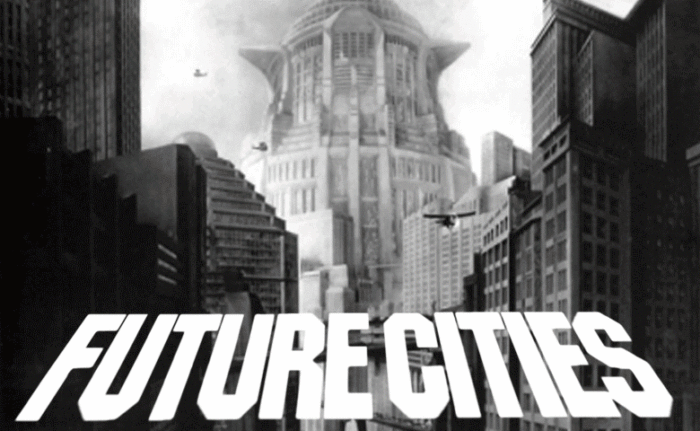FUTURE CITIES
BACK TO THE FUTURE. Last month the Taubman School of Architecture hosted the ambitiously titled Future of Design Conference, bringing together a prestigious group of design professionals to present their thoughts and work on the conference topic. Based on the Pecha Kucha format, each individual was given fifteen minutes to present a rapid-fire succession of projects, speculations, and research, and diatribe. While certain thematic similarities surfaced throughout the course of the presentations, by and large the variety of presented topics reflected the current diversity of the design field. One consistent topic, however, centered on the ways technology is changing the means and methods of architectural production. To contextualize this theme, it is interesting to trace the evolution of technology as it relates to avant-garde architecture and design practices.
Historically, “visionary architecture” has existed as work which is often highly polemic and rarely built. In his book Visionary Architecture: Blueprints of the Modern Imagination, Neil Spiller writes that “this history is linked to the metaphorphosis of the ‘machine’ and the technologies that embody it. Whether ‘machines’ are the conceptual ones of Marchel Duchamp, the mechanized armatures of cranes on a building site, the virtual machines within computers or the cabbalistic machines of Daniel Liebskind, they have all influenced the course of architectural vision.” Works such as, Constant’s New Babylon (1950), Archigram’s Walking City (1964), Superstudio’s Continuous Monument (1971), or even Buckminster Fuller’s proposed Dome for Manhattan (1960), functioned not as serious proposals for built work, but as devices for questioning certain social, political, and technological issues.
Today, these projects are clearly dated in their formal language and graphical representation; nostalgic icons of architectural history rather than relevant architectural projections. Nested in any vision of the future is an image of the present, and these works are clearly products of their time. Yet, what is important about these types of projects is the way they proposed bold, unapologetic alternatives to existing conditions. Instead of remedies based on building a better version of some existing typology, they invented new typologies which completely changed the way the city functioned. These scenarios, while not always based in the reality of sites, budgets, and clients, provided a platform to discuss these and other relevant architectural issues.
NECESSARY FICTIONS. The science fiction writer and cyberpunk icon, William Gibson, famously said that “the future is already here, it’s just not evenly distributed.” While science fiction may be an uncommon place to look for architectural inspiration, there is a close link between the worlds invented by science fiction writers and directors and those imagined by architects and designers. Films such as Fritz Lang’s Metropolis (1926), Stanley Kubrick’s 2001: A Space Odyssey (1968) or Ridley Scott’s Blade Runner (1982) further evolved the sci-fi genre, as well as provide elaborately unique depictions of the future city.
Design is by its nature an act of fiction; the invention of a future through the proposal of new territories, systems and objects injected into existing conditions. As designers and cultural instigators, we are charged with the opportunity and responsibility of distributing the future. Like the films listed above, every design proposal overtly (or covertly) embeds certain cultural practices, biases, and stereotypes. All of which inevitably influence how future inhabitants will understand and occupy these spaces. Whether we intend it or not, each of our designs propose a new “future” by mandating specific interactions between people and their new found environment. Science Fiction offers a moment of critical distance from which to survey the present. It is from this perspective that we can not only question existing social, political, and environmental conditions, but also imagine and test new scenarios and systems.
TOOLS OF THE TRADE. Technology today gives the architect access to previously unknown data regarding climate, structural loading, lighting analysis, and a multitude of other quantifiable information. Software allows us to simulate and anticipate how each building will perform as a future object or landscape. Parametric and script based programs allow the designer to define certain frameworks within which spatial relationships are allowed to fluctuate. These tools have dramatically altered both what we produce as designers as well as how we produce them. While the radical architectural groups and science fiction visionaries gave us dramatic architectural vision, they lacked the technological means to implement these visions in more substantive ways. With such an expanded palette, designers today are met not with the problem of how to use these new technologies, but determining which methods are appropriate to a given situation.
Perhaps most poignant about this particular conference was not the specific future visions presented in as many sleek images and renderings, but how each presenter went about crafting these visions. The event itself, through a mix of high and low-technologies, blogs, open-source software, animation, digital and physical modeling, and written and spoken text, staged an opportunity for designers to create alternative scenarios to our current situation. It created a platform, a critical distance, from which to consider and critique our own design practices and conceits. The real ‘future of design’ will result from the weaving of design and construction technologies within the visionary myths appropriate to our present.





